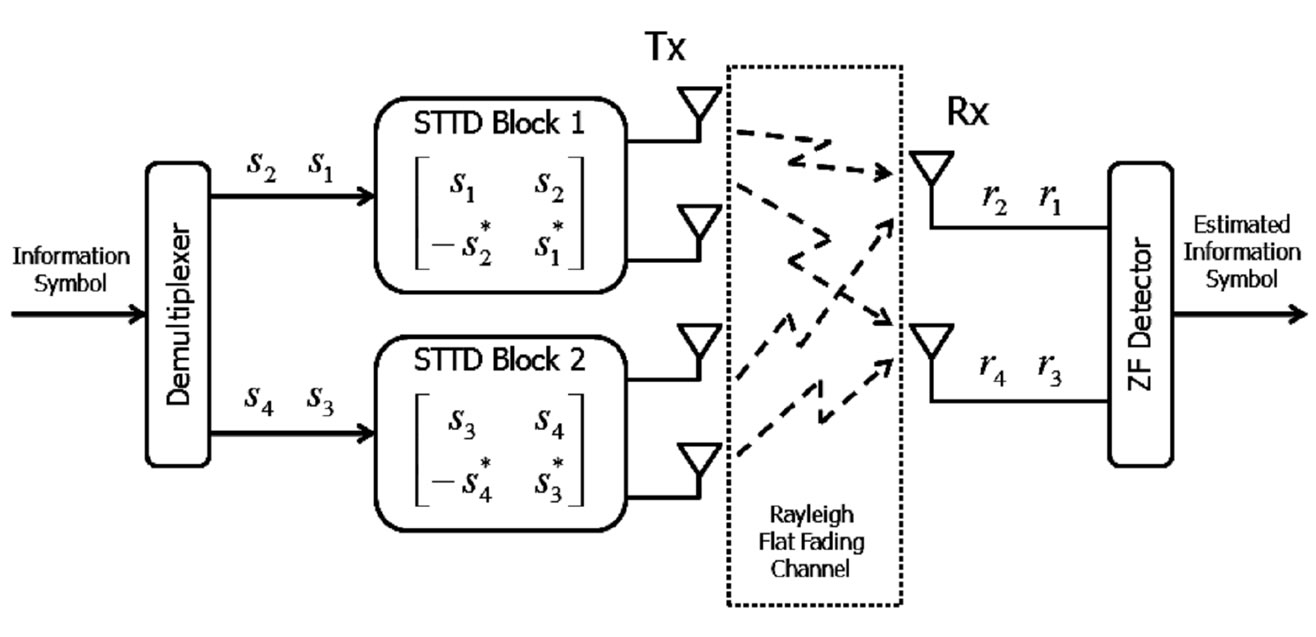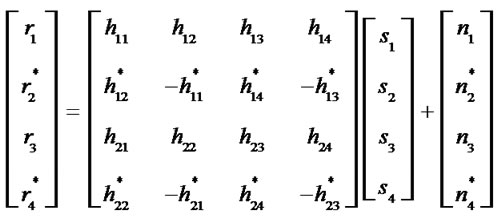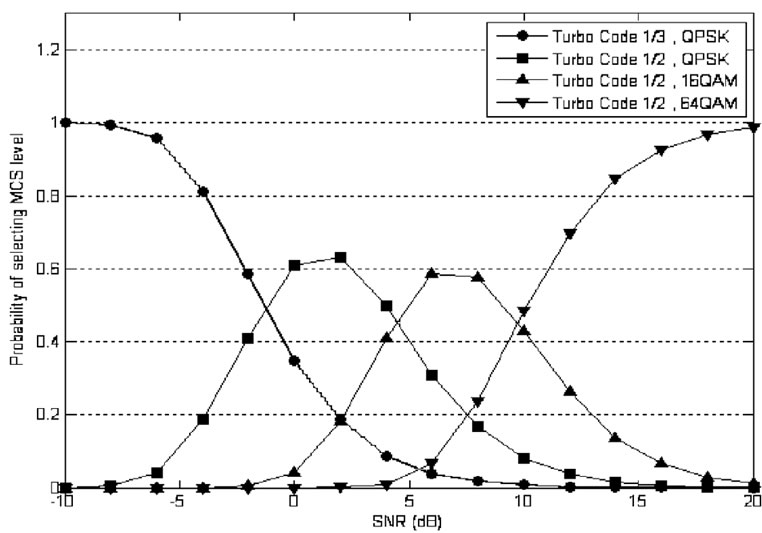Int'l J. of Communications, Network and System Sciences
Vol.2 No.5(2009), Article ID:594,5 pages DOI:10.4236/ijcns.2009.25035
Performance Analysis of the D-STTD Communication System with AMC Scheme
1School of Electronics & Computer Engineering, Chonnam National University, Gwangju, Korea
2Department of Information & Communication System, Kochang Korea Polytechnic College, Gochang, Korea
3Department of Computer Media, Hanyeong College, Yeosu, Korea
4Department of Communications Engineering, Myongji University, Seoul, Korea
Email: sjryoo@empal.com, sjryoo@hanyeong.ac.kr
Received April 6, 2009; revised May 7, 2009; accepted June 10, 2009
Keywords: AMC, MCS Level, STTD, D-STTD
ABSTRACT
In this paper, we propose a Double-Space Time Transmit Diversity (D-STTD) communication system with Adaptive Modulation and Coding (AMC) scheme and analyze its performance using simulation experiments.The simulation results show that the probability of selecting a high Modulation and Coding Scheme (MCS) level increased as the Signal to Noise Ratio (SNR) improved. Furthermore, the D-STTD communication system with AMC scheme provided a more uniform throughput distribution throughout the entire SNR range compared to its counterpart which did not apply AMC scheme. Also, the maximum throughput of the D-STTD communication system with AMC scheme was twice that of a conventional AMC communication system or a Space Time Transmit Diversity (STTD) communication system with AMC scheme.
1. Introduction
With the rapidly increasing demand for high-speed data transmission, next-generation mobile communication is expected to adopt a number of new technologies, including AMC, Orthogonal Frequency Division Multiplexing (OFDM), Multiple Input Multiple Output (MIMO), and Hybrid-Automatic Repeat Request (H-ARQ).
The AMC scheme varies the coding rate and modulation scheme according to the channel status to improve its transmission rate and has been employed in various high-speed wireless communication applications including Wireless Broadband (Wibro) Internet and High Speed Downlink Packet Access (HSDPA). And through continued technical developments, it is expected to be adopted by numerous wireless communication standards of the future. The D-STTD scheme complements the conventional STTD scheme in terms of throughput and its use is being widely discussed regarding various wireless communication standards.
2. AMC Scheme and D-STTD Scheme
The AMC scheme selects an optimal channel coding rate and modulation scheme based on the channel response data for signal transmission, creating a balance between error rate and throughput to improve the overall system throughput and transmission quality. Channel status has a significant effect on signal transmission and reception in the wireless mobile communication environment. Accordingly, a process referred to as link adaptation modifies transmission parameters to compensate for the losses caused by the changes in channel status. The AMC scheme is a type of link adaptation, and its structure is shown in Figure 1 [1-3].
Under a typical wireless communication environment, data is transmitted based on the processes of channel coding, interleaving, and modulation. Signal received via the communication channel is subject to the process of estimating the channel status according to SNR, and the original data is recovered through the reverse process in

Figure 1. Structure of AMC scheme.

Figure 2. Structure of D-STTD scheme.
the transmitter. The estimated channel information is returned to the transmitter, which determines the MCS level based on this information, adjusts channel coding, interleaving, and the modulation scheme suitable for the channel status to carry out transmission. Like above, the AMC scheme selects the MCS level according to the channel status to find a balance between error rate and throughput to help improve the overall system throughput and transmission quality.
The D-STTD scheme is a type of MIMO scheme and expands from the STTD scheme proposed by Alamouti [4-6]. Whereas conventional STTD scheme only provides diversity gain, D-STTD scheme offers multiplexing gain in addition to diversity gain, making it a very effective MIMO scheme. The overall transmission pattern of the D-STTD scheme is shown in Figure 2. The received signal of the D-STTD scheme can be expressed in a simple matrix equation as follows:
 (1)
(1)
where r denotes the received signal and h, s, and n represent channel response, transmitted signal, and noise, respectively. Channel response hij denotes a channel response between j-th transmit antenna and i-th receive antenna. Each channel response is independent and identically distributed (i.i.d.) and displays a complex Gaussian distribution with an average of zero. Noise n is an Additive White Gaussian Noise (AWGN) with an average of zero and a distribution of σ2I.
From Equation (1) and Figure 2, it can be verified that the D-STTD scheme transmits four symbols during two time slots, which corresponds to twice the throughput and the multiplexing gain of the STTD scheme.
3. D-STTD Communication System with AMC Scheme
As a conventional D-STTD communication system uses a fixed channel coding rate and modulation scheme regardless of the channel response status, it can only select and use a low channel coding rate and a low-level modulation scheme in an environment that does not offer a certain level of SNR. On the other hand, a D-STTD communication system with AMC scheme selects a MCS level based on SNR information to flexibly apply the channel coding rate and the modulation scheme according to the channel response status, securing an optimal throughput at any given SNR.
Figure 3 shows the structure of a D-STTD communication system with AMC scheme. It can be seen that AMC scheme is incorporated into the D-STTD scheme explained in Chapter 2 to complement the system structure. The initially created data undergoes coding and interleaving processes based on the channel selected by the MCS level selector and is modulated with the modulation scheme also selected by the MCS level selector. The modulated signal is encoded by the D-STTD encoder for transmission over the channel and converted to an estimation of the original signal by the D-STTD decoder at the receiver. The signal then goes through the reverse process of the transmitter, and the original signal is restored.
4. Simulation Results
This chapter comparatively analyzes throughput of a conventional system and the D-STTD communication system with AMC scheme. Tables 1 and 2 list the MCS level selection criteria and the environmental parameters for the simulation experiment, which were prepared according to HSDPA and 3G Long Term Evolution (LTE) standards [7-9].

Figure 3. Structure of D-STTD communication system with AMC scheme.

Table 1. MCS levels.

Table 2. Simulation Parameters.
Figure 4 shows the throughput of a D-STTD 4×2 communication system for a fixed MCS level in the Rayleigh Flat Fading channel. As mentioned in Chapter 3, data is transmitted without loss for MCS level 1 (QPSK, Turbo Code 1/3) with the low SNR of roughly 2dB. However, at MCS level 4 (64QAM, Turbo Code 1/2), the data is transmitted without loss when SNR is 18dB or higher. If we assume that AMC scheme is not applied, a single coding rate and a specific modulation scheme must be selected, the coding rate and the modulation scheme that correspond to MCS levels 3 or 4 are inevitably excluded from the outset because they both have high probabilities of frame errors in low SNR range.
Figure 5 shows the MCS level selection probability of a D-STTD 4×2 communication system with the AMC scheme under the Rayleigh Flat Fading channel converted to an overall probability of 1. A low MCS level is selected for a low SNR range, and as the channel status improved along with the SNR, the probability of selecting a higher MCS level increased.

Figure 4. Throughput of a D-STTD 4×2 communication system for a fixed MCS level in the Rayleigh Flat Fading channel.

Figure 5. Probability of MCS level selection in a D-STTD 4×2 communication system with AMC scheme.

Figure 6. Throughput of each system in the Rayleigh Flat Fading channel.
Figure 6 indicates the throughput performance of each communication system in the Rayleigh Flat Fading channel. The conventional communication system applying only the AMC scheme showed the lowest throughput. Although the average throughput of the STTD 2×1 communication system with AMC scheme was somewhat improved, its maximum throughput was identical to that of the conventional system with AMC scheme. The average throughput of the STTD 2×2 communication system with AMC scheme was improved in the whole SNR ranges due to the receive diversity effect.
It was confirmed that the maximum throughput of the D-STTD 4×2 communication system with AMC scheme was twice that of the system that only applied AMC scheme or the STTD communication system with AMC scheme, which is the result of the multiplexing gain of D-STTD scheme explained in Chapter 2. Moreover, comparison of Figures 4 and 6 confirms that the D-STTD 4×2 communication system with AMC scheme shows a more uniform throughput over the entire SNR ranges than the D-STTD 4×2 communication system that uses a fixed coding rate and modulation scheme without AMC scheme.
In the case of the D-STTD 4×4 communication system with AMC scheme, the average throughput improved because the receive diversity effect was added to the D-STTD 4×2 system with AMC scheme.
5. Conclusions
This paper proposed a D-STTD communication system with AMC scheme, examined its structure and characteristics and comparatively analyzed the performances. The results of the simulation experiments indicated that the proposed system yielded improved throughput in most SNR ranges from the conventional AMC communication system as well as the STTD communication system with AMC scheme. The maximum throughput improved by 100%. Moreover, the benefits of the AMC scheme provided a more uniform throughput throughout the SNR range as compared to using a single coding rate and a single modulation scheme. Possible topics of future studies include incorporating several detection techniques, such as asymmetric modulation and antenna shuffling, to the D-STTD communication system with AMC scheme to secure better throughput and transmission quality throughout the whole SNR ranges.
6. Acknowledgments
This work was supported by the Korea Research Foundation Grant funded by the Korean Government (MOEHRD, Basic Research Promotion Fund) (KRF-2008- 331-D00374).
7. References
[1] B. Vucetic, “An adaptive coding scheme for time-varying channels,” IEEE Transactions on Communications, Vol. 39, pp. 653-663, May 1991.
[2] A. J. Goldsmith and S. G. Chua, “Variable-rate variablepower MQAM for fading channels,” IEEE Transactions on Communications, Vol. 45, No. 10, pp. 1218-1230, October 1997.
[3] A. J. Goldsmith and S. G. Chua, “Adaptive coded modulation for fading channels,” IEEE Transactions on Communications, Vol. 46, No. 5, pp. 595-602, May 1998.
[4] S. M. Alamouti, “A simple diversity technique for wireless communications,” IEEE Journal on Selected Areas in Communications, Vol. 16, No. 8, pp. 1451-1458, October 1998.
[5] Texas Instruments, “Double-STTD scheme for HSDPA systems with four transmit antennas: Link level simulation results,” TSG-R WG1 document, TSGR1#20(01)04 58, Busan, Korea, May 21-24, 2001.
[6] H. J. Lee, E. J. Powers, and J. Kang, “Low-complexity ZF detector for D-STTD systems in time-selective fading channels,” Vehicular Technology Conference, IEEE 62nd, pp. 2043-2047, September 25-28, 2005.
[7] 3GPP TS 25.212 TSG RAN Multiplexing and channel coding (FDD).
[8] 3GPP TS 25.222 TSG RAN Multiplexing and channel coding (TDD).
[9] 3GPP TS 25.944 TSG RAN Channel coding and multiplexing examples.

